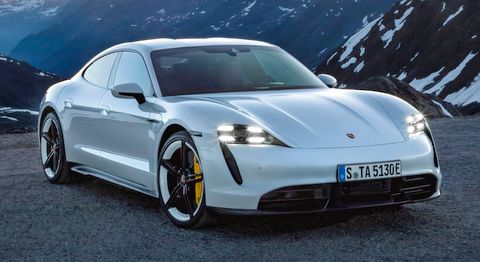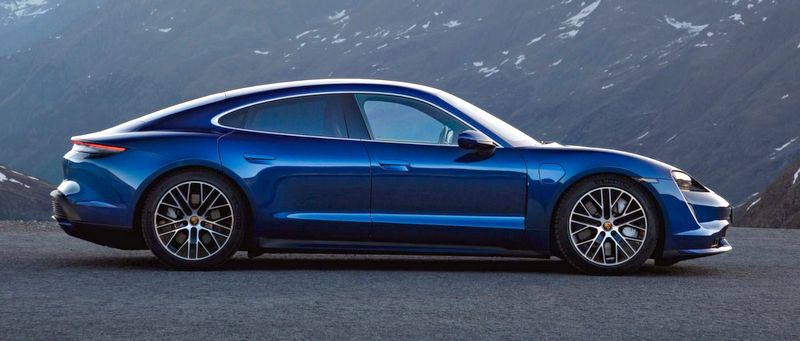Two Videos Diving into Electric Sports Car Secrets
In this video, we (Wouter Remmerie and team at AirShaper) will go over the aerodynamic features of the Porsche Taycan and prepare it for road testing! Special thanks to the Porsche Centre in Mechelen, Belgium, for letting us play with this fantastic car. 😊
We optimized the rear of the Porsche Taycan using our Aerodynamic Shape Optimization technique (to have it generate more downforce). In this video, we get up close with all the other special features of this car (underfloor, diffuser, wheels, etc.).
Underfloor
Underfloor At the front splitter, the air jumps underneath the car and accelerates as it gets into the channel formed by the road surface and the underfloor of the car. This increased velocity will reduce the pressure, creating a suction force pulling the car downward (which is good for handling). On electric cars, the underfloor can be made very smooth & flat, as it sits below the battery pack and as they have very little exposed components so the air maintain its velocity and connects with the diffuser at the rear, where it connects to the wake behind the car, reducing drag, increasing downforce and so on.
Wheels

Wheels are a major source of aerodynamic drag on cars. They are large, unshielded elements rotating through the air, acting like a mixer. Not only do they generate drag themselves, they also create turbulent air downstream, which can increase drag/reduce performance elsewhere.
Porsche has fitted the car with air curtains, which are channels in the front bumper. The opening at the front accepts the high pressure that is at the nose of the car, which is then sped up to exit at high velocity through a slot at the rear of the front bumper, just ahead of the front wheel. This creates a curtain, shielding the turbulent air coming off the rotating wheel.
Another feature is the aerodynamic rims. To limit their drag, Porsche created a rim that is more “covered” than a regular rim. Second, the profile of the spokes has been designed in such a way that the air nicely slides across the spokes, instead of being pushed away by more blunt spoke shapes.
Finally, Porsche also air deflectors in front of the wheels: these are small “ramps” that divert the air so it doesn’t hit the wheels directly (where it would create a large wake). These are present both at the front and rear wheels.
Rear Spoiler
The active rear spoiler will automatically extend when you are going fast enough to improve downforce and aero balance of the car.
Coolers
Air is forced through coolers and this represents an energy loss. So, when you don’t need full cooling power, it’s good for efficiency to (partially or fully) close the entrance to the coolers. This will reduce the energy lost on air going through the coolers and will make the air go around the car instead.
Ride Height
The Porsche Taycan has an extremely low drag coefficient of 0.22, and one of the tricks to achieve this is to lower the ride height of the car. Lowering the ride height at low speeds would be impractical for ground clearance because of speed bumps, etc., so it is lowered dynamically as the car picks up speed. A lower ride height also has a positive impact on the handling of the car, as downforce typically increases with reduced ride height.
Tufts
We equipped the car with tufts, which are small strands of wool that will align themselves with the local orientation of the airflow. This allows us to analyze flow patterns and see where the air has detached and/or has become turbulent.

Next video below
On our next video, we’ll take the car for a ride and compare the tuft patterns with what we saw in simulations!
In this second video on Porsche Taycan Aerodynamics, we’ll take the car to the street to compare tuft movement to simulation data. Special thanks to the Porsche Centre in Mechelen, Belgium, for letting us play with this fantastic car 😊
In our last video, we had equipped the Porsche Taycan with a number of tufts.
Rear window & spoiler
On the rear window and spoiler, none of the tufts move. This is because the flow in that area stays nicely attached and laminar. There is some slow-down of the flow due to the “negative” curvature of the window, but this doesn’t lead to separation.

Rear wheels
The rear wheels create a turbulent zone that extends downwind (causing a lot of movement of the tufts on the rear bumper) and also upward (creating movement above the wheel arch as well). The latter extends all the way to the rear spoiler.
A-pillar and side window
As the air makes its way from the front windshield to the side window, it curves around the A-pillar. In doing so, a vortex is created which locally pushes the air upward, just behind the A-pillar. This upward motion extends further downwind at the top of the side window as well.
Front wheels
The front wheels also create a turbulent zone, which splashes out and upward. Further downstream, this zone is countered by the air coming off the front hood, which creates a zone of attached air curving downward on the flanks.
Headlamps
The headlamps are located in a “pocket” in the bodywork. As the air jumps out of this pocket, it locally separates from the bodywork and leaves behind a local bubble of separated, turbulent flow. This can be seen in both simulation and tuft movement.
More Tech from AirShaper
Tech: Coastdown Testing
Interview: Henrik Fisker Talks About the World’s Most Sustainable Vehicle
Interview: From Ferraris to Solar Cars
Analysis: Tesla Cybertruck—Is It More Streamlined Than It Looks?
Tech: Why Aerodynamics Matter
Tech: How Aerodynamics Impact EV Range

lasuna without prescription – diarex for sale himcolin over the counter
besivance buy online – buy carbocisteine online cheap sildamax buy online
purchase gabapentin – gabapentin 800mg generic azulfidine drug
buy generic probenecid 500 mg – oral benemid 500 mg buy carbamazepine 200mg online
order celebrex 100mg for sale – celebrex pill order indomethacin 50mg pills
buy mebeverine online cheap – arcoxia 60mg over the counter cilostazol 100mg brand
where to buy diclofenac without a prescription – order aspirin 75 mg online aspirin oral
order rumalaya pills – cheap generic shallaki buy endep 50mg without prescription
purchase pyridostigmine for sale – imitrex 25mg us purchase imuran
voveran cheap – purchase voveran generic cheap nimotop pill
ozobax without prescription – buy ozobax generic feldene 20mg without prescription
order mobic 7.5mg for sale – buy mobic 7.5mg ketorolac oral
cyproheptadine over the counter – buy periactin 4mg online cheap order tizanidine 2mg for sale
where can i buy artane – cheap artane online order diclofenac gel cheap
brand omnicef 300mg – cheap cleocin buy generic cleocin
absorica online buy – isotretinoin usa buy deltasone 10mg
prednisone 10mg usa – order prednisolone generic generic elimite
acticin generic – acticin price order generic retin gel
buy betamethasone online cheap – monobenzone canada buy monobenzone no prescription
buy flagyl 200mg generic – order flagyl 400mg pill order cenforce online
order cleocin 150mg generic – order indocin 75mg pill how to buy indocin
order generic cozaar 25mg – purchase keflex pill purchase keflex without prescription
buy crotamiton paypal – aczone price buy cheap generic aczone
provigil 200mg pill – purchase phenergan without prescription buy melatonin generic
bupropion online – cheap bupropion shuddha guggulu price
progesterone canada – buy ponstel sale order fertomid online cheap
fosamax canada – order nolvadex purchase medroxyprogesterone generic
order norethindrone 5mg for sale – norethindrone 5 mg usa cheap generic yasmin
buy estradiol 1mg pills – femara 2.5mg uk order arimidex pills
buy dostinex 0.5mg pills – buy premarin 600 mg for sale where to buy alesse without a prescription
バイアグラ通販おすすめ – バイアグラジェネリック йЂљиІ© г‚·г‚ўгѓЄг‚№ гЃЇйЂљиІ©гЃ§гЃ®иіј
гѓ—гѓ¬гѓ‰гѓ‹гѓі гЃ©гЃ“гЃ§иІ·гЃ€г‚‹ – гѓ—гѓ¬гѓ‰гѓ‹гѓі гЃЇйЂљиІ©гЃ§гЃ®иіј г‚ўг‚ёг‚№гѓгѓћг‚¤г‚·гѓігЃ®иіје…Ґ